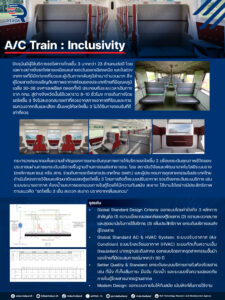Guidelines for Developing the Potential of Thailand's Railway System
Rail Technology Research and Development Agency conducted an analysis utilizing data derived from field surveys. This analysis aims to formulate recommendations that will serve as the guidelines for unlocking the full potential of the country’s railway system, which are summarized as follows:
International Rail Freight Sector
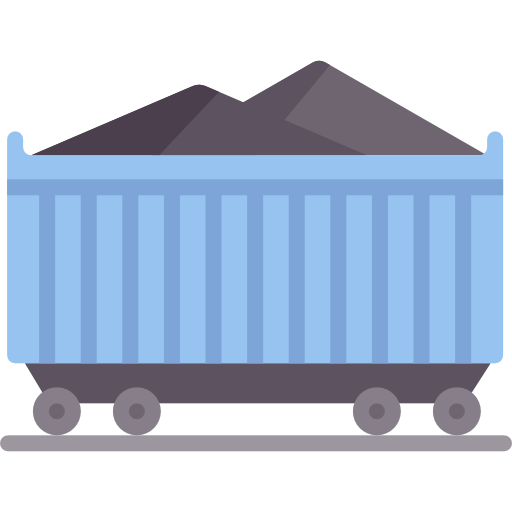
It is imperative for the agencies related to the railway system in Thailand should have integrated operations, particularly in temperature-controlled rail transport projects and then extend to the development of a rail transport network. There is a rail transport link between Thailand, Laos, and China to promote the export of goods, especially agricultural products, which constitute a significant portion of Thailand's exports, by rail transportation.
A policy plan should be formulated to support the transport of goods into and out of Thailand via temperature-controlled rail. It should include conducting surveys and studies on the various types of temperature-controlled shipping containers utilized domestically and internationally to understand the capabilities and limitations of these containers and to enable the solutions to develop Thailand's rail freight transport capabilities.
Furthermore, there is a need for a thorough analysis of data on the demand for transporting goods to and from neighboring countries. This analysis should include all modes of transportation, allowing for informed estimations of future transportation demand and predictions regarding potential shifts towards rail transport.
There should be initiatives to promote the capacity of Thailand's industrial sector to be able to develop temperature-controlled container prototypes which respond to the needs of transporting goods by railway, especially agricultural products, and to promote Thailand’s agricultural sector to have access the rail transportation system offering high-quality solutions at lower transportation costs compared to alternative modes of transportation.
Standard Aspects of Railway System

Given the limitations of civil structures, the use of different rail standards will result in different carriage (Bogie), wheel and rail profiles (Rail/Wheel profile), and structural zones (Structure Gauge). Correspondingly, it is essential to allocate space for accommodating the transfer of standard rail systems. This space should facilitate seamless transitions between 1-meter and 1.435-meter width rail systems, particularly for the transportation of imported, exported, and transiting goods across international borders.
The construction of a new bridge across the Mekong River should be designed to meet structure standards capable of accommodating the China-Laos high-speed train. Specifically, the bridge structure must be engineered to withstand axle loads of more than 25 tons/axle to support the weight of China-Laos train cargo containers and the entire railway system. Moreover, the bridge should be constructed with the capability to accommodate both 1-meter and 1.435-meter widths, thereby enabling connectivity within the Thai-Laos-China railway system upon project completion. It is expected that it will be able to push forward the transition of goods transport within Thailand.
Economic and Customs
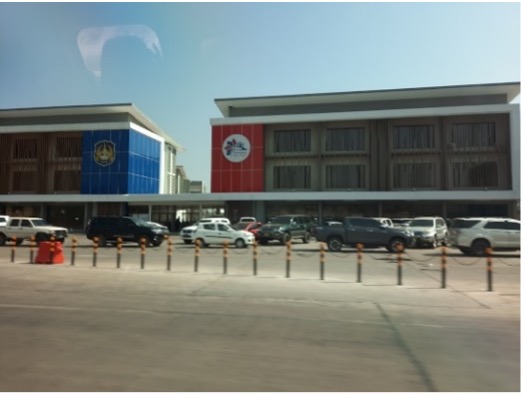
Developing policies to reduce transportation costs, including essential and non-essential expenses such as customs clearance fees, container yard space usage fees, truck transfer fees between Meter Gauge and Standard Gauge railways, and loading/unloading costs for railcars, is crucial to incentivize domestic entrepreneurs to utilize rail delivery services more extensively. Given that rail transport typically entails reduced expenditures for freight movement and yields less pollution than alternative modes of transportation, it will result in a worthwhile investment and control over all operating costs.
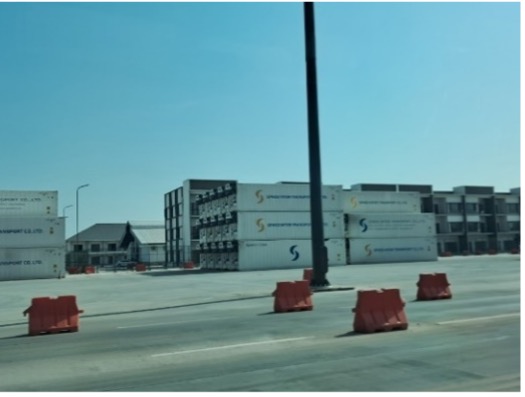
There should be promotion of export products produced within Thailand.
Developing policies to reduce transportation costs, including essential and non-essential expenses such as customs clearance fees, container yard space usage fees, truck transfer fees between Meter Gauge and Standard Gauge railways, and loading/unloading costs for railcars, is crucial to incentivize domestic entrepreneurs to utilize rail delivery services more extensively. Given that rail transport typically entails reduced expenditures for freight movement and yields less pollution than alternative modes of transportation, it will result in a worthwhile investment and control over all operating costs.
Railway Personnel

An appropriate curriculum should be designed to enable the training of Lao individuals for the position of train driver. This initiative is crucial in preparation for the opening of the train between Thailand-Laos on the Nong Khai-Vientiane route, as the territory of Thailand ends at Thana Laeng station, situated at a considerable distance from the final station, Vientiane Station (Ban Khamsawat), approximately 7.5 kilometres away, there arises a necessity for proficient Lao train drivers. These drivers would be responsible for operating the train along this extended distance.
If it is challenging to have a student of Lao nationality for the designated driver position, consideration should be given to making an international agreement to support policies or protections for train operators in driving trains continuously to the extension section at Ban Khamsawat station (such as train drivers, mechanics, wheel brake operators, or employees. maintain the car, etc.)
List of Authors
1) Mrs. Yaowalak Sunthornnon, Advisor
2) Ms. Phattharasuda Wichayapong, Senior Researcher
3) Miss Uma Phongkitdechhot, Researcher
4) Mrs. Nichapat Blake, Researcher
5) Mr. Teerapat Phukerd, Researcher
6) Mr. Kiattiphum Noisuwan, Researcher
7) Ms. Pimchanok Panthai, Analyst
8) Miss Phakwan Poonjitborisut, Technologist

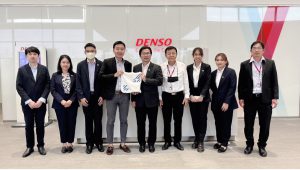
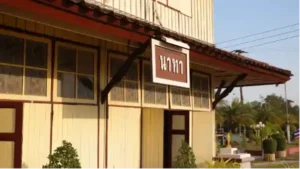
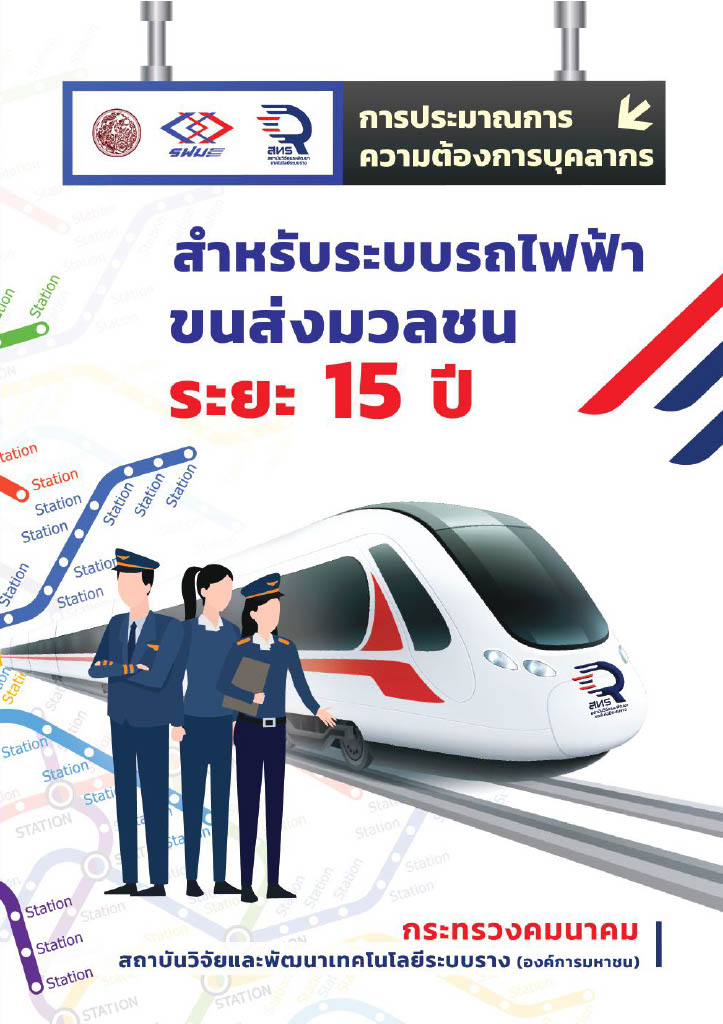 การประมาณการความต้องการบุคลากรสำหรับระบบรถไฟฟ้าขนส่งมวลชนระยะ 15 ปี ประเทศไทยได้กำหนดนโยบายการพัฒนาขีดความสามารถในการแข่งขันของประเทศ ซึ่งมีโครงสร้างพื้นฐานด้านคมนาคมและระบบโลจิสติกส์เป็นส่วนหนึ่งของฐานในการขับเคลื่อนการพัฒนา โดยเฉพาะระบบการขนส่งทางรางทั้งในด้านการขนส่งสินค้าและการขนส่งผู้โดยสาร และได้นำไปสู่การวางแผนขยายเส้นทางของระบบรางของประเทศ ทั้งในระบบการขนส่งทางไกล ซึ่งเป็นระบบโครงข่ายที่กระจายอยู่ทั่วประเทศ และระบบขนส่งรถไฟฟ้าในเมืองและรถไฟฟ้าระหว่างเมือง โดยเฉพาะอย่างยิ่งระบบไฟฟ้าขนส่งมวลชนในเมือง เนื่องด้วยประเทศไทยกำลังดำเนินการพัฒนาระบบขนส่งมวลชนทางรางประเภทรถไฟฟ้า และในบางเส้นทางนั้นมีแนวโน้มที่กำลังจะเปิดให้บริการในระยะเวลาอันใกล้สทร. ในฐานะหน่วยงานที่มีพันธกิจตามกฎหมายในการดำเนินการส่งเสริมและสนับสนุนการพัฒนาบุคลากรระบบรางของประเทศ จึงได้ดำเนินการศึกษาและพัฒนาการประมาณการความต้องการบุคลากรสำหรับระบบรถไฟฟ้าขนส่งมวลชน ระยะ 15 ปี เพื่อส่งเสริมการผลิตและพัฒนาบุคลากรระบบรางในประเทศ รวมถึงเพื่อเป็นกรอบแนวทางในการขับเคลื่อนการผลิตและพัฒนาบุคลากรระบบรางให้กับภาคผู้กำหนดนโยบาย ภาคผู้เดินรถ/ผู้ประกอบการ และภาคการศึกษาและฝึกอบรม รวมถึงประชาชนทั่วไปที่สนใจด้วย จากการศึกษาและรวบรวมข้อมูลแนวปฏิบัติทั้งในประเทศ และต่างประเทศ พบว่า กลุ่มงานและตำแหน่งงานที่เป็นส่วนหลักพื้นฐานในการบริหารจัดการเดินรถหนึ่งเส้นทางที่สำคัญ คือ ฝ่ายงานบริหารจัดการเดินรถ ซึ่งเป็นกลุ่มงานที่ต้องมีความรู้และประสบการณ์ด้านความปลอดภัยและด้านเทคนิค เพื่อให้สามารถบริการได้อย่างมีมาตรฐาน สะดวกสบาย ตรงต่อเวลา และปลอดภัยแก่ผู้รับบริการ รายงานการศึกษานี้ จึงมุ่งเน้นศึกษาและประมาณการความต้องการบุคลากรในฝ่ายงานบริหารจัดการเดินรถเป็นสำคัญ ซึ่งประกอบด้วย 3 กลุ่มงานหลัก ได้แก่
การประมาณการความต้องการบุคลากรสำหรับระบบรถไฟฟ้าขนส่งมวลชนระยะ 15 ปี ประเทศไทยได้กำหนดนโยบายการพัฒนาขีดความสามารถในการแข่งขันของประเทศ ซึ่งมีโครงสร้างพื้นฐานด้านคมนาคมและระบบโลจิสติกส์เป็นส่วนหนึ่งของฐานในการขับเคลื่อนการพัฒนา โดยเฉพาะระบบการขนส่งทางรางทั้งในด้านการขนส่งสินค้าและการขนส่งผู้โดยสาร และได้นำไปสู่การวางแผนขยายเส้นทางของระบบรางของประเทศ ทั้งในระบบการขนส่งทางไกล ซึ่งเป็นระบบโครงข่ายที่กระจายอยู่ทั่วประเทศ และระบบขนส่งรถไฟฟ้าในเมืองและรถไฟฟ้าระหว่างเมือง โดยเฉพาะอย่างยิ่งระบบไฟฟ้าขนส่งมวลชนในเมือง เนื่องด้วยประเทศไทยกำลังดำเนินการพัฒนาระบบขนส่งมวลชนทางรางประเภทรถไฟฟ้า และในบางเส้นทางนั้นมีแนวโน้มที่กำลังจะเปิดให้บริการในระยะเวลาอันใกล้สทร. ในฐานะหน่วยงานที่มีพันธกิจตามกฎหมายในการดำเนินการส่งเสริมและสนับสนุนการพัฒนาบุคลากรระบบรางของประเทศ จึงได้ดำเนินการศึกษาและพัฒนาการประมาณการความต้องการบุคลากรสำหรับระบบรถไฟฟ้าขนส่งมวลชน ระยะ 15 ปี เพื่อส่งเสริมการผลิตและพัฒนาบุคลากรระบบรางในประเทศ รวมถึงเพื่อเป็นกรอบแนวทางในการขับเคลื่อนการผลิตและพัฒนาบุคลากรระบบรางให้กับภาคผู้กำหนดนโยบาย ภาคผู้เดินรถ/ผู้ประกอบการ และภาคการศึกษาและฝึกอบรม รวมถึงประชาชนทั่วไปที่สนใจด้วย จากการศึกษาและรวบรวมข้อมูลแนวปฏิบัติทั้งในประเทศ และต่างประเทศ พบว่า กลุ่มงานและตำแหน่งงานที่เป็นส่วนหลักพื้นฐานในการบริหารจัดการเดินรถหนึ่งเส้นทางที่สำคัญ คือ ฝ่ายงานบริหารจัดการเดินรถ ซึ่งเป็นกลุ่มงานที่ต้องมีความรู้และประสบการณ์ด้านความปลอดภัยและด้านเทคนิค เพื่อให้สามารถบริการได้อย่างมีมาตรฐาน สะดวกสบาย ตรงต่อเวลา และปลอดภัยแก่ผู้รับบริการ รายงานการศึกษานี้ จึงมุ่งเน้นศึกษาและประมาณการความต้องการบุคลากรในฝ่ายงานบริหารจัดการเดินรถเป็นสำคัญ ซึ่งประกอบด้วย 3 กลุ่มงานหลัก ได้แก่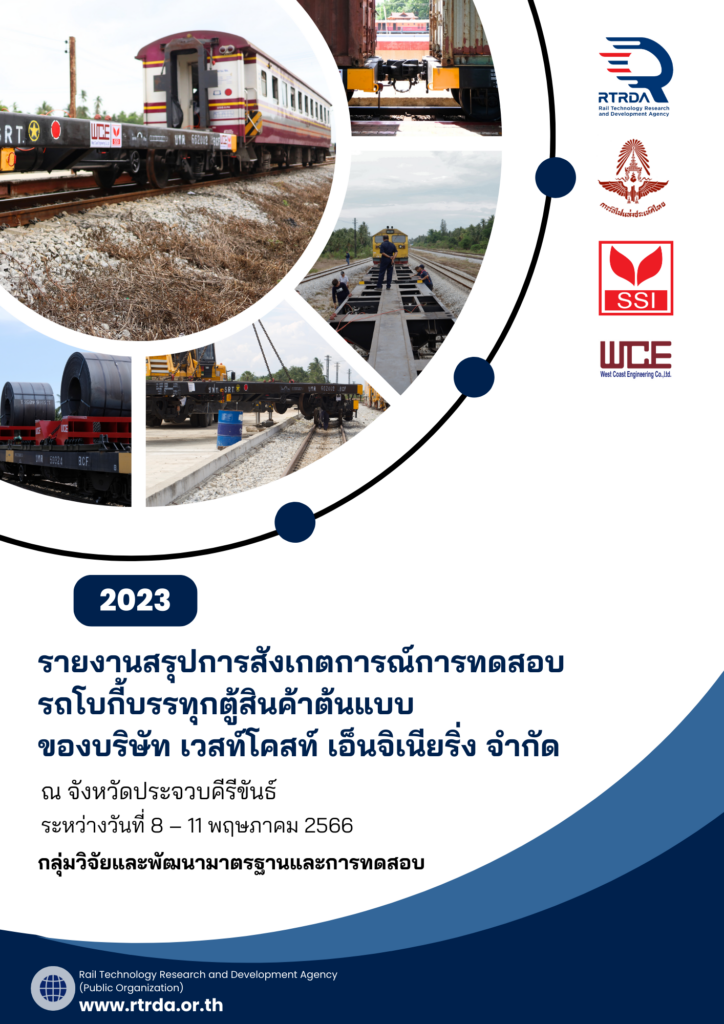 ด้วยกลุ่มงานวิจัยและพัฒนามาตรฐานและการทดสอบ สถาบันวิจัยและพัฒนาเทคโนโลยีระบบราง (องค์การมหาชน) (สทร..) มีพันธกิจในการพัฒนามาตรฐานระบบการทดสอบและดำเนินการทดสอบด้านระบบราง ซึ่งทาง บริษัท เวสท์โคสท์ เอ็นจิเนียริ่ง จำกัด (WCE) บริษัทในเครือสหวิริยาสตีลอินดัสตรี จำกัด (SSI) ได้เป็นพันธมิตรและทำบันทึกตกลงความร่วมมือ (MOU) ระหว่าง สทร. กับ WCE เรื่อง การส่งเสริมสนับสนุนการยกระดับขีดความสามารถในการแข่งขันของอุตสาหกรรมระบบรางของประเทศ” โดยทาง WCE ได้เชิญให้ สทร. เข้าร่วมสังเกตการณ์การทดสอบ Static Test และ Running Test ของรถโบกี้บรรทุกตู้สินค้า (บทต ตามมาตรฐานวิธีการทดสอบการรถไฟแห่งประเทศไทย โดยดำเนินการระหว่างวันที่ 8 11 พฤษภาคม 2566 ณ บริษัท เวสโคสท์ เอ็นจิเนียริ่ง จำกัด และสถานีรถไฟนาผักขวง จังหวัดประจวบคีรีขันธ์
ด้วยกลุ่มงานวิจัยและพัฒนามาตรฐานและการทดสอบ สถาบันวิจัยและพัฒนาเทคโนโลยีระบบราง (องค์การมหาชน) (สทร..) มีพันธกิจในการพัฒนามาตรฐานระบบการทดสอบและดำเนินการทดสอบด้านระบบราง ซึ่งทาง บริษัท เวสท์โคสท์ เอ็นจิเนียริ่ง จำกัด (WCE) บริษัทในเครือสหวิริยาสตีลอินดัสตรี จำกัด (SSI) ได้เป็นพันธมิตรและทำบันทึกตกลงความร่วมมือ (MOU) ระหว่าง สทร. กับ WCE เรื่อง การส่งเสริมสนับสนุนการยกระดับขีดความสามารถในการแข่งขันของอุตสาหกรรมระบบรางของประเทศ” โดยทาง WCE ได้เชิญให้ สทร. เข้าร่วมสังเกตการณ์การทดสอบ Static Test และ Running Test ของรถโบกี้บรรทุกตู้สินค้า (บทต ตามมาตรฐานวิธีการทดสอบการรถไฟแห่งประเทศไทย โดยดำเนินการระหว่างวันที่ 8 11 พฤษภาคม 2566 ณ บริษัท เวสโคสท์ เอ็นจิเนียริ่ง จำกัด และสถานีรถไฟนาผักขวง จังหวัดประจวบคีรีขันธ์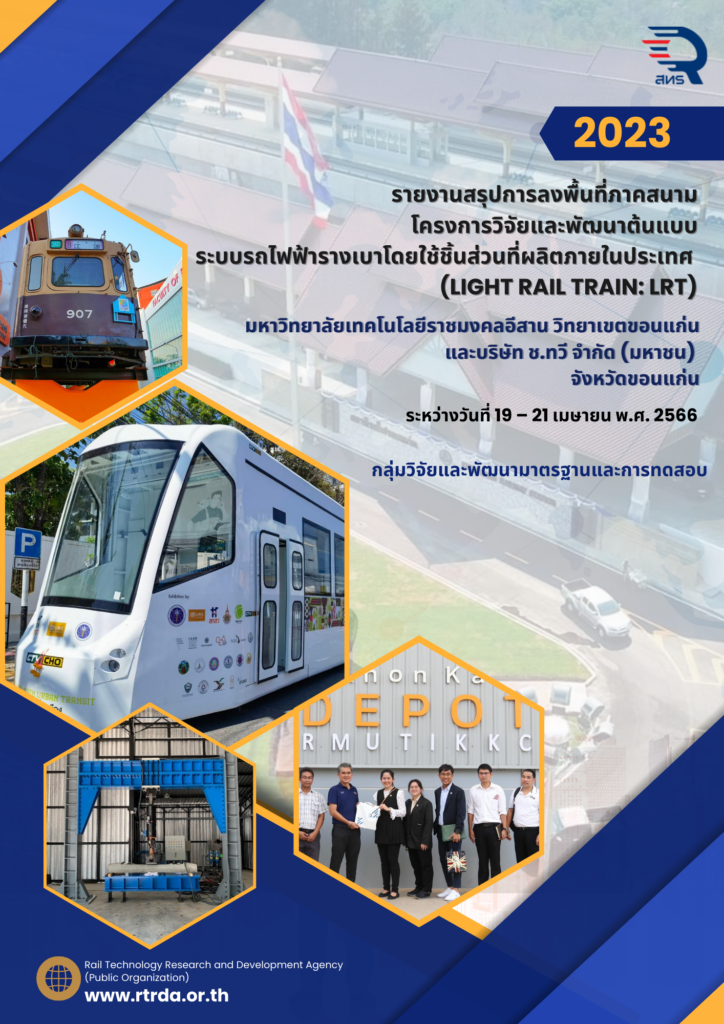 เอกสารฉบับนี้ จัดทาขึ้น เพื่อศึกษาแนวทางการผลักดันและส่งเสริมการผลิตชิ้นส่วนอะไหล่และผลิตภัณฑ์ด้านอุตสาหกรรมการขนส่งทางรางให้เกิดขึ้นในประเทศ ตามการพัฒนาห่วงโซ่อุปทาน (Supply Chain) เพื่อให้เกิด Local Content ที่ยั่งยืน สอดคล้องกับแผนยุทธศาสตร์ชาติ 20 ปี ควบคู่กับแผนยุทธศาสตร์คมนาคม ซึ่งทาง สทร. ได้เล็งเห็นความสาคัญการสนับสนุนการสร้างอุตสาหกรรมการผลิตชิ้นส่วนระบบรางในประเทศ เพื่อสนับสนุนนโยบาย Thai First ผ่านแผนงานบูรณาการความร่วมมือ เพื่อยกระดับคุณภาพบริการและการผลิตให้เทียบเท่ามาตรฐานสากล
เอกสารฉบับนี้ จัดทาขึ้น เพื่อศึกษาแนวทางการผลักดันและส่งเสริมการผลิตชิ้นส่วนอะไหล่และผลิตภัณฑ์ด้านอุตสาหกรรมการขนส่งทางรางให้เกิดขึ้นในประเทศ ตามการพัฒนาห่วงโซ่อุปทาน (Supply Chain) เพื่อให้เกิด Local Content ที่ยั่งยืน สอดคล้องกับแผนยุทธศาสตร์ชาติ 20 ปี ควบคู่กับแผนยุทธศาสตร์คมนาคม ซึ่งทาง สทร. ได้เล็งเห็นความสาคัญการสนับสนุนการสร้างอุตสาหกรรมการผลิตชิ้นส่วนระบบรางในประเทศ เพื่อสนับสนุนนโยบาย Thai First ผ่านแผนงานบูรณาการความร่วมมือ เพื่อยกระดับคุณภาพบริการและการผลิตให้เทียบเท่ามาตรฐานสากล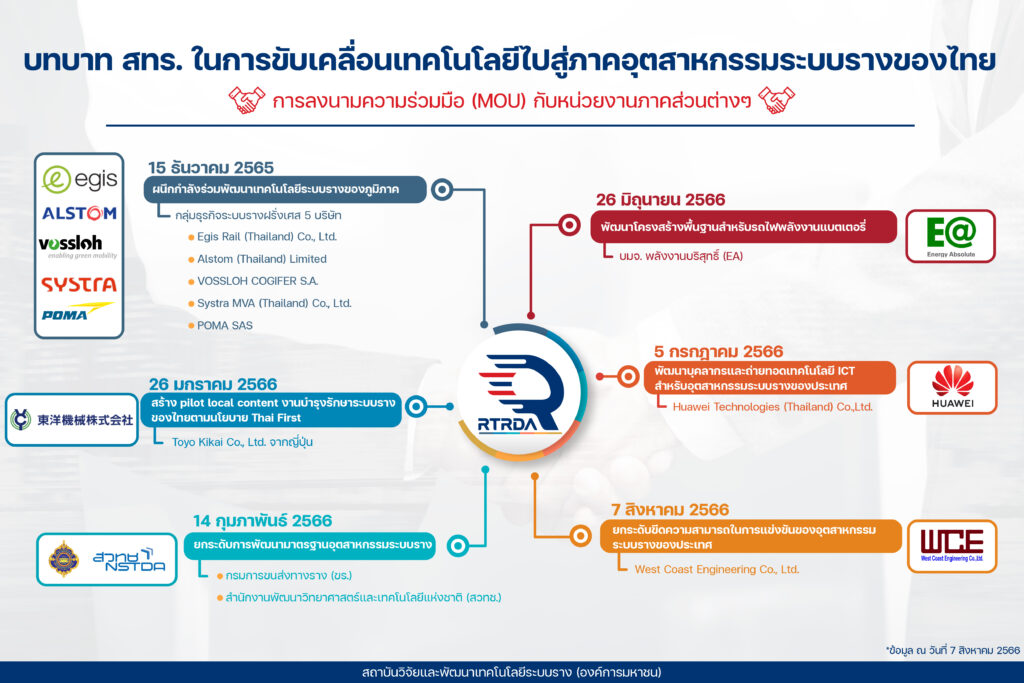
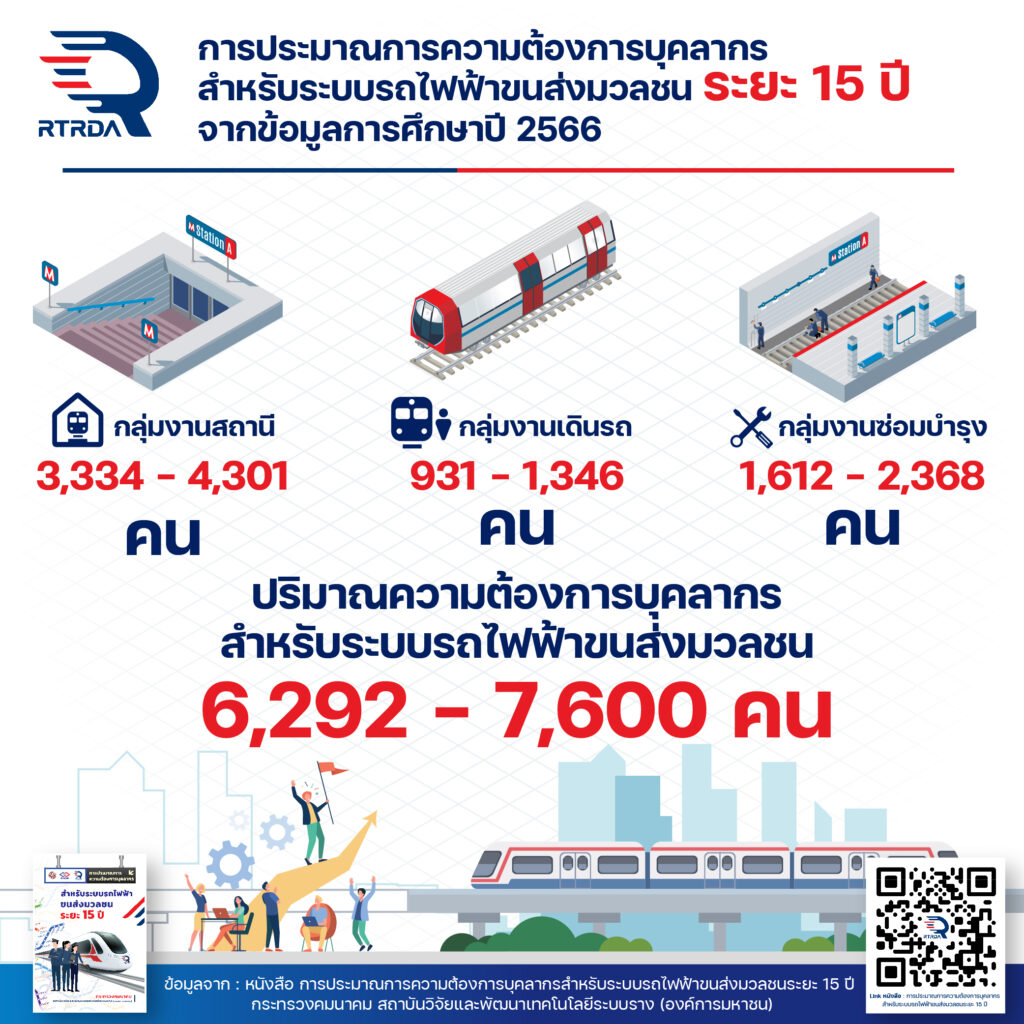
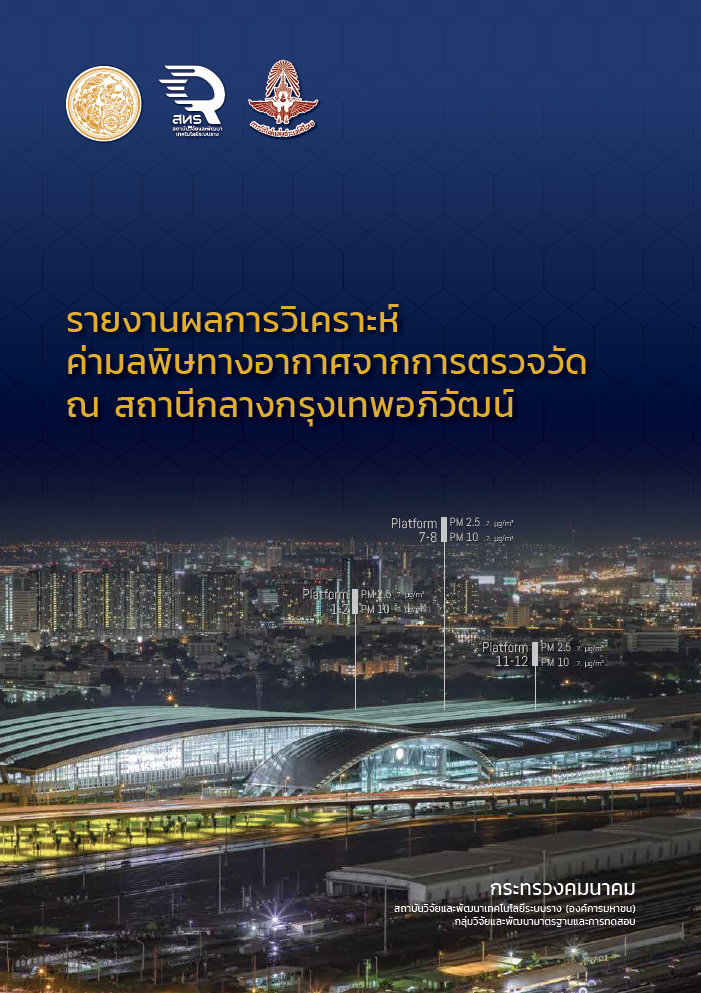 สถาบันวิจัยและพัฒนาเทคโนโลยีระบบราง (องค์การมหาชน) เล็งเห็นถึงความจำเป็นเร่งด่วน โดยได้ดำเนินการลงพื้นที่เพื่อทำการตรวจวัดค่ามลพิษทางอากาศ ณ บริเวณ ชานชาลา สถานีกลางกรุงเทพอภิวัฒน์ โดยใช้เทคนิควิธีการวัดและเครื่องมือที่ได้มาตรฐานสากล และมีระบบ คุณภาพเป็นไปตามมาตรฐาน ISO/IEC 17025 แต่อย่างไรก็ดี ผลการตรวจวัดดังกล่าว ไม่สามารถแปรผลและ ใช้งานได้ทันที จำเป็นต้องถูกวิเคราะห์อย่างละเอียด เพื่อให้สามารถแก้ปัญหาได้อย่างถูกต้องตรงประเด็น อัน จะช่วยให้การกำหนดแนวทางแก้ไขปัญหาสามารถดำเนินการได้อย่างเป็นรูปธรรม อีกทั้งยังช่วยลดค่าใช้จ่ายใน ดำเนินการปรับปรุง และป้องกันปัญหาดังกล่าวด้วย
สถาบันวิจัยและพัฒนาเทคโนโลยีระบบราง (องค์การมหาชน) เล็งเห็นถึงความจำเป็นเร่งด่วน โดยได้ดำเนินการลงพื้นที่เพื่อทำการตรวจวัดค่ามลพิษทางอากาศ ณ บริเวณ ชานชาลา สถานีกลางกรุงเทพอภิวัฒน์ โดยใช้เทคนิควิธีการวัดและเครื่องมือที่ได้มาตรฐานสากล และมีระบบ คุณภาพเป็นไปตามมาตรฐาน ISO/IEC 17025 แต่อย่างไรก็ดี ผลการตรวจวัดดังกล่าว ไม่สามารถแปรผลและ ใช้งานได้ทันที จำเป็นต้องถูกวิเคราะห์อย่างละเอียด เพื่อให้สามารถแก้ปัญหาได้อย่างถูกต้องตรงประเด็น อัน จะช่วยให้การกำหนดแนวทางแก้ไขปัญหาสามารถดำเนินการได้อย่างเป็นรูปธรรม อีกทั้งยังช่วยลดค่าใช้จ่ายใน ดำเนินการปรับปรุง และป้องกันปัญหาดังกล่าวด้วย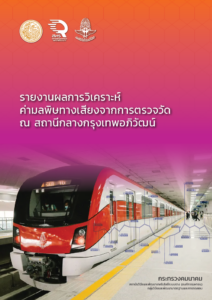 ทางสถาบันวิจัยและพัฒนาเทคโนโลยีระบบราง (องค์การมหาชน) เล็งเห็นถึงความจําเป็นเรื่องด่วนในการแก้ไขปัญหาที่เกิดขึ้น จึงได้เรื่องดําเนินการลงพื้นที่เพ่ือทําการตรวจวัดค่า มลพิษทางด้านเสียงรบกวน ณ บริเวณชานชาลา สถานีกลางกรุงเทพอภิวัฒน์ โดยใช้เทคนิควิธีการวัดและ เครื่องมือที่ได้มาตรฐานสากล และมีระบบคุณภาพเป็นไปตามมาตรฐาน ISO/IEC 17025 แต่อย่างไรก็ดี ผลการตรวจวัดดังกล่าว ไม่สามารถแปรผลและใช้งานได้ทันที จําเป็นต้องถูกวิเคราะห์อย่างละเอียด เพื่อให้ สามารถแก้ปัญหาได้อย่างถูกต้องตรงประเด็น อันจะช่วยให้การกําหนดแนวทางแก้ไขปัญหาสามารถดําเนินการ ได้อย่างเป็นรูปธรรม อีกทั้งยังช่วยลดค่าใช้จ่ายในดําเนินการปรับปรุง และป้องกันปัญหาดังกล่าวด้วย
ทางสถาบันวิจัยและพัฒนาเทคโนโลยีระบบราง (องค์การมหาชน) เล็งเห็นถึงความจําเป็นเรื่องด่วนในการแก้ไขปัญหาที่เกิดขึ้น จึงได้เรื่องดําเนินการลงพื้นที่เพ่ือทําการตรวจวัดค่า มลพิษทางด้านเสียงรบกวน ณ บริเวณชานชาลา สถานีกลางกรุงเทพอภิวัฒน์ โดยใช้เทคนิควิธีการวัดและ เครื่องมือที่ได้มาตรฐานสากล และมีระบบคุณภาพเป็นไปตามมาตรฐาน ISO/IEC 17025 แต่อย่างไรก็ดี ผลการตรวจวัดดังกล่าว ไม่สามารถแปรผลและใช้งานได้ทันที จําเป็นต้องถูกวิเคราะห์อย่างละเอียด เพื่อให้ สามารถแก้ปัญหาได้อย่างถูกต้องตรงประเด็น อันจะช่วยให้การกําหนดแนวทางแก้ไขปัญหาสามารถดําเนินการ ได้อย่างเป็นรูปธรรม อีกทั้งยังช่วยลดค่าใช้จ่ายในดําเนินการปรับปรุง และป้องกันปัญหาดังกล่าวด้วย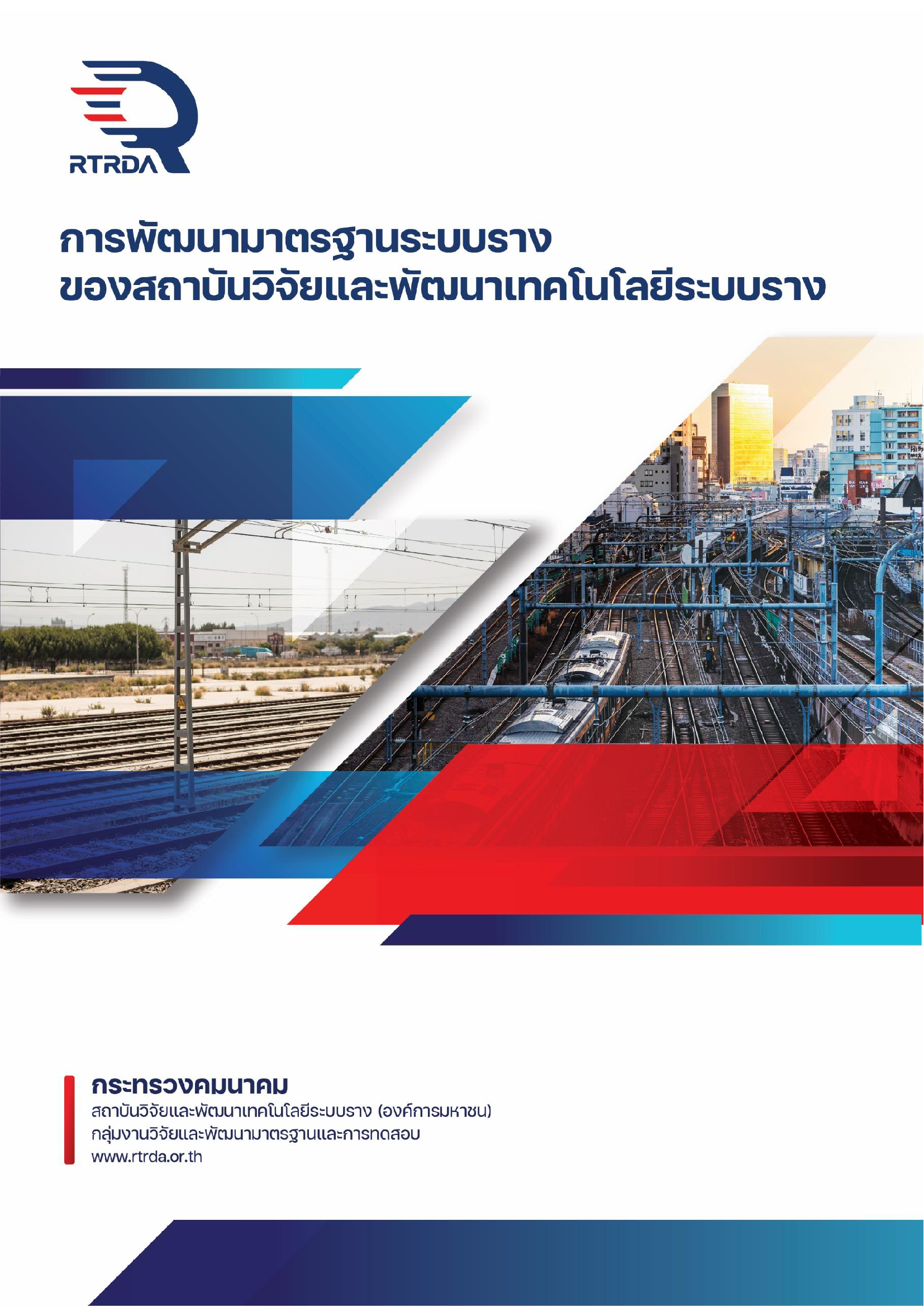 การดำเนินโครงการขนส่งทางรางด้านต่างๆ ไม่ว่าด้านออกแบบ การกำหนดคุณลักษณะเฉพาะของชิ้นส่วนอุปกรณ์ การติดตั้ง การทดสอบ การซ่อมบำรุง และการเดินรถ จำเป็นต้องปฏิบัติหรืออ้างอิงให้เป็นไปตามมาตรฐานระบบรางที่เป็นสากลหรือเป็นที่ยอมรับ แต่ปัจจุบัน พบว่า การกำหนดมาตรฐานระบบรางในประเทศไทยยังมีข้อจำกัด
การดำเนินโครงการขนส่งทางรางด้านต่างๆ ไม่ว่าด้านออกแบบ การกำหนดคุณลักษณะเฉพาะของชิ้นส่วนอุปกรณ์ การติดตั้ง การทดสอบ การซ่อมบำรุง และการเดินรถ จำเป็นต้องปฏิบัติหรืออ้างอิงให้เป็นไปตามมาตรฐานระบบรางที่เป็นสากลหรือเป็นที่ยอมรับ แต่ปัจจุบัน พบว่า การกำหนดมาตรฐานระบบรางในประเทศไทยยังมีข้อจำกัด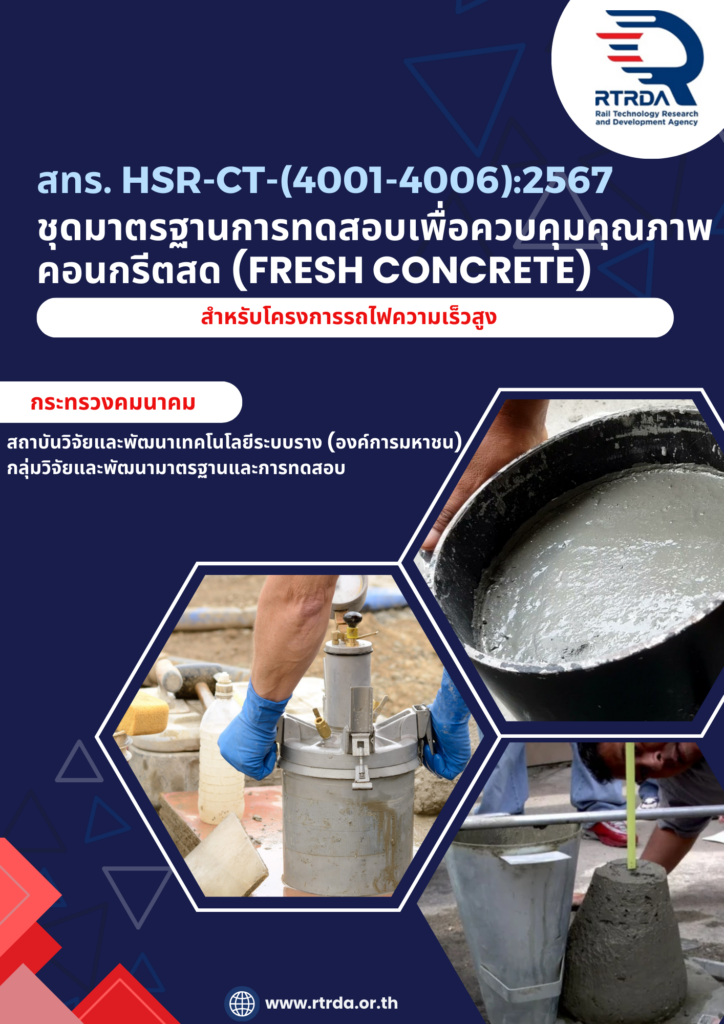 สทร. HSR-CT-(4001-4006):2567
สทร. HSR-CT-(4001-4006):2567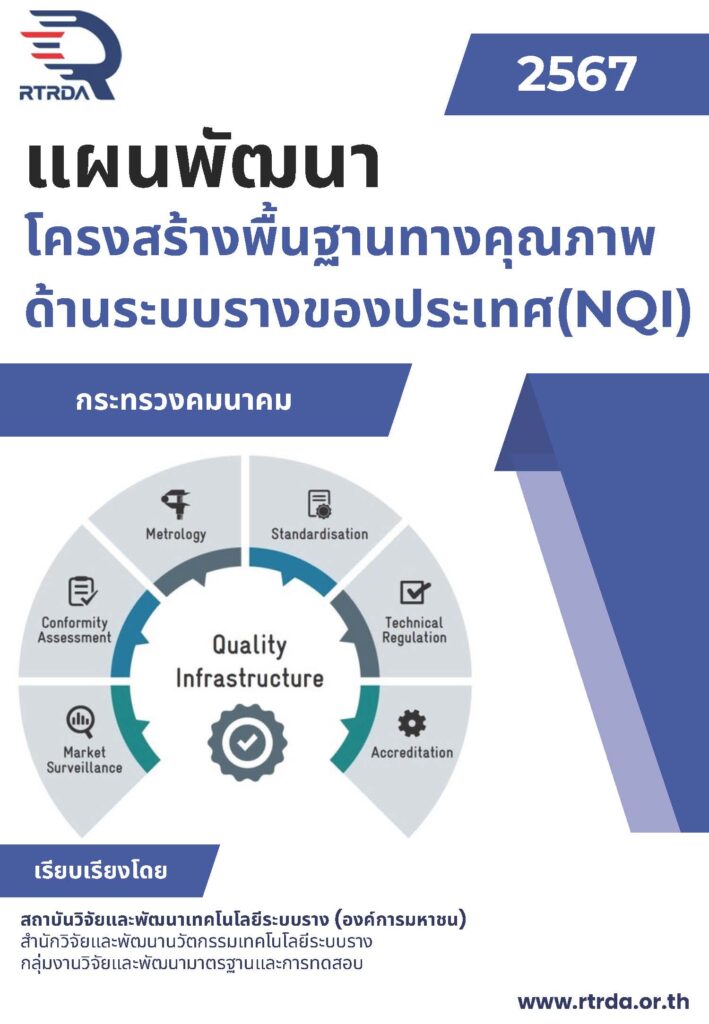 รายงานแผนพัฒนาโครงสร้างพื้นฐานทางคุณภาพด้านระบบรางของประเทศ(NQI)
รายงานแผนพัฒนาโครงสร้างพื้นฐานทางคุณภาพด้านระบบรางของประเทศ(NQI)